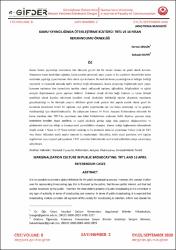| dc.contributor.author | Zengin, Ferhat | |
| dc.contributor.author | Kapır, Bahadır | |
| dc.date.accessioned | 2023-11-07T14:10:00Z | |
| dc.date.available | 2023-11-07T14:10:00Z | |
| dc.date.issued | 2020 | en_US |
| dc.identifier.issn | 2146-3301 | |
| dc.identifier.uri | https://hdl.handle.net/11363/6263 | |
| dc.description.abstract | Kamu hizmet yayıncılığı kavramının tüm dünyada geçerli tek bir tanımı olmasa da genel olarak kavram;
finansmanı kamu tarafından sağlanan, kamu yararını gözeterek yayın yapan ve bu yayınların denetiminin kamu
tarafından yapıldığı yayın biçimini ifade etmek için kullanılır. Bu nedenle kamu yayıncılığının en belirgin özelliği
yayıncılık ve ekonomik anlamda hiçbir otoriteye bağlı olmamasıdır. Kamu yayıncılığı bağlamında yayın yapan
kurumun toplumun tüm kesimlerine tarafsız olarak yaklaşarak toplumu eğlendirici, bilgilendirici ve eğitici
amaçlar doğrultusunda yayın yapması beklenir. Hukuksal olarak devlete bağlı bulunan ve kamu iktisadi
teşebbüsü olarak kurulan televizyon kanalları resmî ideolojinin belirlediği sınırlar ekseninde yayınlarını
gerçekleştirdiği ve bu ideolojik çerçeve dâhilinde gerek etnik gerekse dini yapıda azınlık olarak genel bir
kavramda tanımlanan belirli bir topluma veya gruba yayınlarında eşit söz hakkı tanımadığı ve bu grupları
ötekileştirdiği için eleştirilmektedirler. Bu çalışmanın konusu 16 Nisan Anayasa Referandumu sürecinde bir
kamu kuruluşu olan TRT1’de yayınlanan ana haber bültenlerinde toplumun farklı düşünce yapısına sahip
kesimlerini temsilen siyasi partilerin ve çeşitli ideolojik görüşe sahip olan grupların düşüncelerinin ve
görüşlerinin nasıl yer aldığı ve kamuya nasıl yansıtıldıkları olmuştur. Zaman aralığı bağlamında referandumla
ilişkili olarak 1 Nisan ve 15 Nisan tarihleri seçilmiş ve bu aralıktaki hafta içi yayınlanan ‘Erhan Çelik ile TRT
Ana Haber’ bültenleri içerik analizi yöntemi ile incelenmiştir. Böylelikle, farklı siyasi partilerin, sivil toplum
örgütlerinin veya eleştirel yaklaşımların TRT1 ana haber bültenlerinde nasıl temsil edildikleri ortaya çıkarılmaya
çalışılmıştır. | en_US |
| dc.description.abstract | It is not possible to provide a global definition for the public broadcasting concept. However, this concept is often
used for representing broadcasting type that is financed by the public, that favours public interest, and that had
audited broadcasts by the public. Therefore, the most distinct property of public broadcasting is it is not linked to
any type of authority in terms of broadcasting and economy. In terms of public broadcasting, it is expected that
broadcasting institute considers all segments of the society for broadcasting to entertain, inform and educate the society. Television channels that are operating legally under state and established as public economic enterprise
are criticised as these channels broadcast along an axis determined by the limits of official ideology and within
this framework of ideology, not providing equal right of speaking to ethnic and religious minorities or alienated
such minorities with hate speech. As a part of this ideologic “equal distance”, this study aims to discover how
ideas and opinions of political parties that represent different segments of society and different groups are
represented in evening news broadcast in TRT1 as a public institution and how these ideas and opinions are
reflected across the public during 16 April constitution referendum process. In terms of timeframe related with
the referendum, 1 April and 15 April and “TRT News with Erhan Çelik” broadcast during weekdays are selected
and evaluated with content analysis method. Thus, the representation of different political parties, NGOs and
critical approaches in TRT1 evening news are analysed. | en_US |
| dc.language.iso | tur | en_US |
| dc.publisher | Mustafa Cankut | en_US |
| dc.rights | info:eu-repo/semantics/openAccess | en_US |
| dc.rights | Attribution-NonCommercial-NoDerivs 3.0 United States | * |
| dc.rights.uri | http://creativecommons.org/licenses/by-nc-nd/3.0/us/ | * |
| dc.subject | Kamusal Yayıncılık | en_US |
| dc.subject | Referandum | en_US |
| dc.subject | Anayasa | en_US |
| dc.subject | Ötekileştirme | en_US |
| dc.subject | Kamusal Alanda Temsil | en_US |
| dc.subject | Public Broadcasting | en_US |
| dc.subject | Referendum | en_US |
| dc.subject | Constitution | en_US |
| dc.subject | Marginalisation | en_US |
| dc.subject | Representation in Public Space | en_US |
| dc.title | Kamu Yayıncılığında Ötekileştirme Kültürü: Trt1 ve 16 Nisan Referandumu Örnekliği | en_US |
| dc.title.alternative | Marginalisation Culture in Public Broadcasting: Trt1 and 16 April Referendum Cases | en_US |
| dc.type | article | en_US |
| dc.relation.ispartof | Gümüşhane Üniversitesi İletişim Fakültesi Elektronik Dergisi | en_US |
| dc.department | Uygulamalı Bilimler Yüksekokulu | en_US |
| dc.authorid | 0000-0002-6785-3257 | en_US |
| dc.authorid | 0000-0002-4602-9859 | en_US |
| dc.identifier.volume | 8 | en_US |
| dc.identifier.issue | 2 | en_US |
| dc.identifier.startpage | 1145 | en_US |
| dc.identifier.endpage | 1178 | en_US |
| dc.relation.publicationcategory | Makale - Ulusal Hakemli Dergi - Kurum Öğretim Elemanı | en_US |
| dc.contributor.institutionauthor | Zengin, Ferhat | |



















